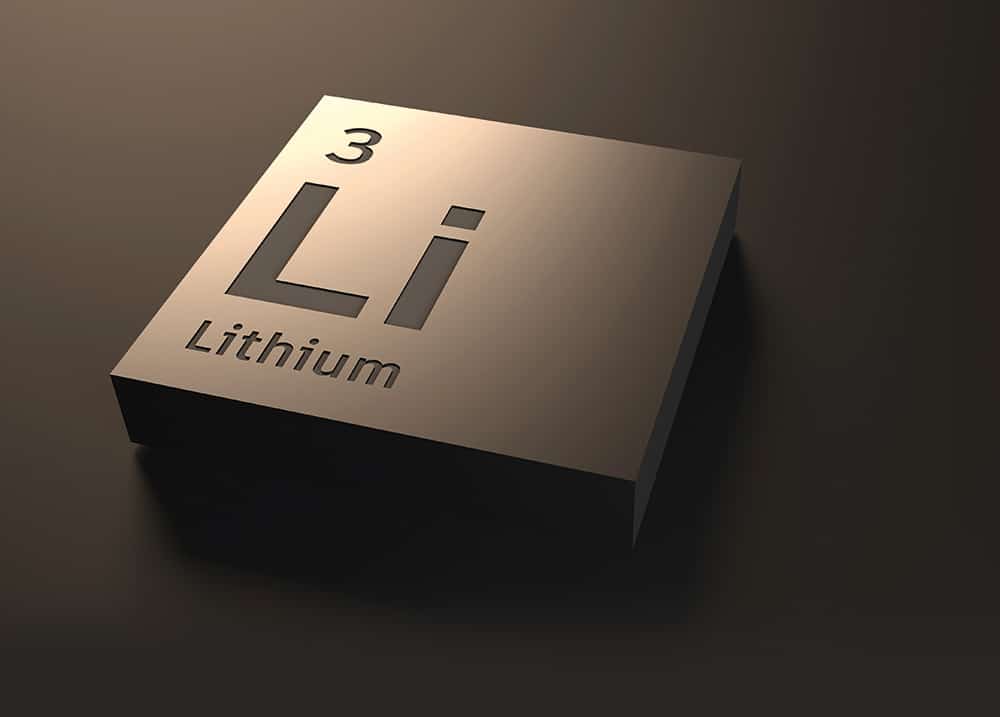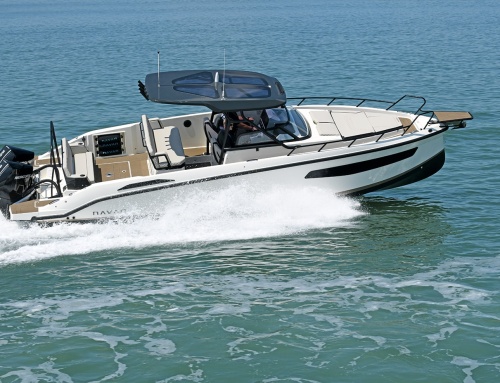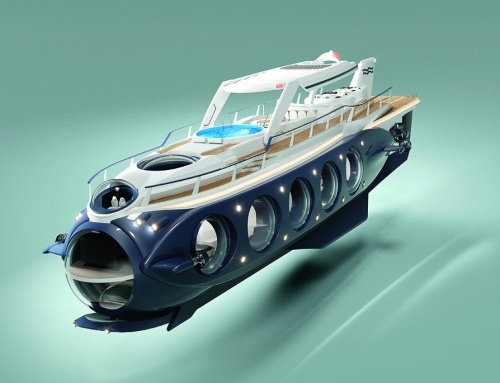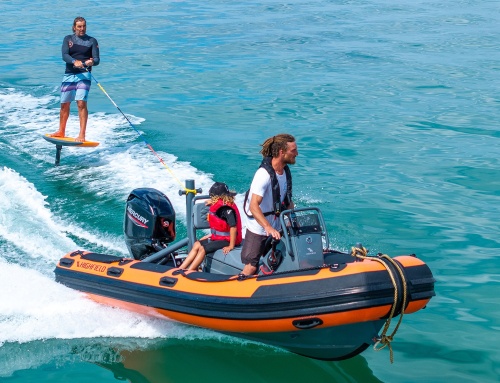Is the use of lithium-ion batteries plain sailing? PBR’s Jeremy Webb investigates the pros, the cons and the technology behind the power and in the process uncovers a host of sobering, timely facts relative to everyone putting to sea.
You can’t go anywhere now without using some form of battery-powered technology as governments push the use of electric-powered transport. From electric bicycles to electric aircraft, they all use lithium-ion batteries that can be recharged hundreds, if not thousands, of times. The marine industry has seen a massive increase in the use of lithium batteries in all sectors, but are they truly the next best thing? In this article, we shall benefit from the input of leading experts in this field, seek to ‘debunk’ some of the misconceptions surrounding lithium-ion technology, and take a good honest look at both the pros and the cons associated with this highly technical power source.
This article follows our ‘Is electric boating green?’ article.
Divided opinions on the use of lithium-ion batteries
The use of lithium-ion, or li-ion, batteries in the marine industry is dividing opinions. Manufacturers producing the batteries and those using them in their products promote the benefits they provide to users, while operators and some users warn people of the dangers surrounding using these batteries. There are also many people shouting out about the negative impact that the production of lithium batteries is having on the planet.
In my discussions with industry professionals, manufacturers and agencies connected with this market, it has become clear that there are positives and negatives associated with the use of lithium-ion batteries. The subject is pretty vast, so I’ve had to be selective to a degree about the areas I focus on. To this end, I will forego dwelling too extensively on the environmental and sustainability issues involved. But I do appreciate, as I’m sure you do, that everything to do with technology comes at a cost. When it involves the manufacturing of an item or the advancing of a certain technology, the responsible course to take is one that seeks to balance the ‘fors and againsts’ with the aim of calculating the real impacts involved. This process should take in redundancy, an accurate understanding of application, and the true long-term advantages and disadvantages at play, as well as the need for a forward-thinking vision that isn’t solely focused on short-term gain. When it comes to the development and application of a technology such as lithium-ion battery power, we rely to a certain extent upon industry leaders having already completed a responsible degree of due diligence – a process that takes in the wider implications of their commercial rationale.

Engine manufacturers are developing great electric motors. Mercury have a easy removable battery and charging App.
Key facts
- You should install a Battery Management System on your vessel or make sure the lithium batteries you purchase have a BMS installed. A BMS battery management system comprises several key components working together to deliver optimal performance from the battery pack. The components are:
- A battery charger. A charger feeds power into the battery pack at the correct voltage and flow rate to ensure it is optimally charged.
- A battery monitor. The battery monitor is a suite of sensors that monitor the batteries’ health and other crucial information like the charging status and temperature.
- A battery controller. The controller manages the charge and discharge of the battery pack. It ensures that the power enters and leaves the battery pack optimally.
- Connectors. These connectors connect the BMS system, the batteries, the inverter and, when applicable, the solar panel.
Definition & application
In layman’s terms, then, what does a lithium-ion battery consist of? The answer is: several cells, each containing a positive and a negative electrode, an anode and a cathode. Between the cells is an ion-conducting and liquid electrolyte that guarantees the transport of the lithium ions between the electrodes during the charging or discharging process. Another essential component is the ‘separator’, which prevents direct contact between the anode and cathode, thus protecting against short circuits.
Lithium-ion batteries are used everywhere within the marine industry, especially in the watercraft and leisure equipment world, where they have an application in connection to those items commonly referred to as ‘toys’ – products commonly kept in the garages of large motor yachts and the like. These can range from electric surfboards to electric-powered mini-submarines. There are also, of course, a growing number of brands producing electric-powered boats and outboard motors for the tender market (see info box detailing some of the market leaders).
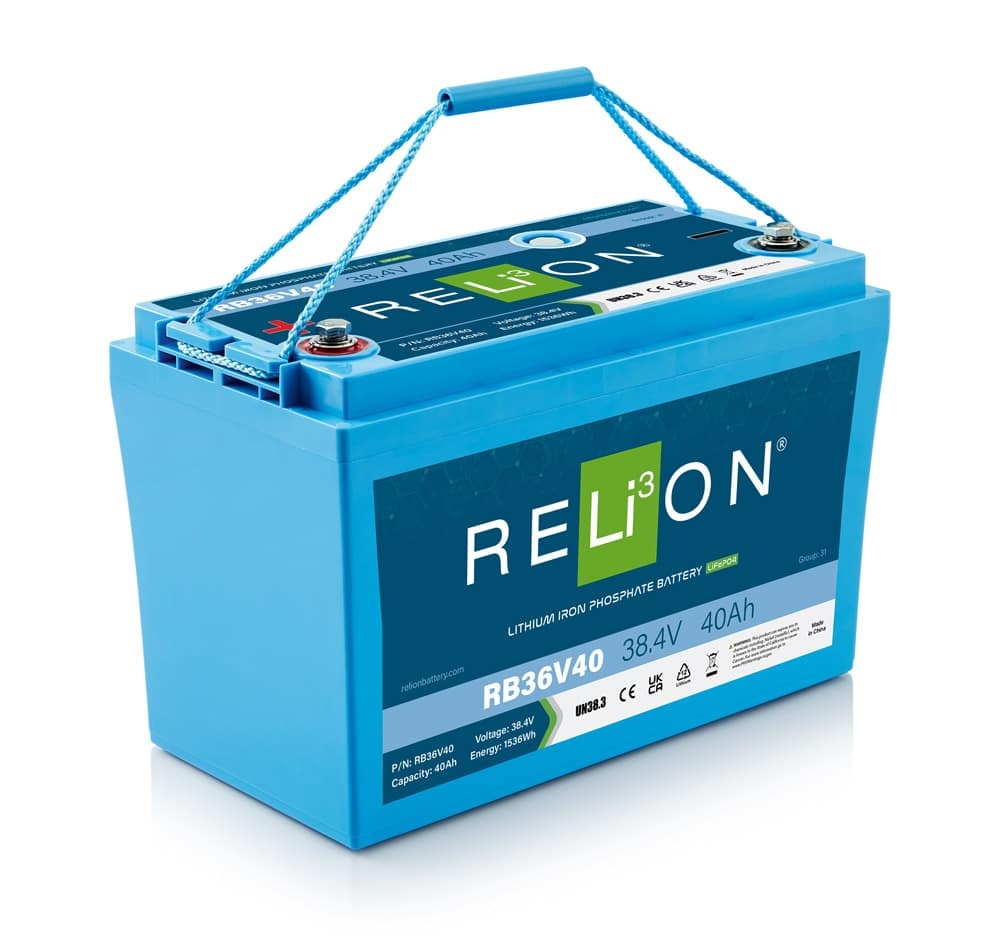
RELiON Battery Debuts a New 36V Lithium Battery. This is the first 36V marine battery in the brand’s product line.
In terms of their advantages, lithium-ion batteries can provide outstanding degrees of power, and when applied to a propulsion unit, they can allow the latter to operate free of vibration, without noise and cleanly too. But it is essential to choose a Lithium-ion battery suitable for the job in hand and from a reputable manufacturer. A high-end lithium-ion boat battery should be capable of intermittent and fast charging, be constructed with durability in mind, possess high power output as well as sufficient storage capacity. Likewise, it needs to be resistant to corrosion, require minimal or zero maintenance and be capable of extended storage life. It would appear that a lithium battery recommended by a good many within the marine sector is the, RELiON RB100-LT. This particular unit is a 12V 100Ah LiFePO4 type which also boasts an internal monitoring and heating system that allows safe charging at temperatures as low as -20°C (-4°F). In fact, it’s purposefully designed for exceptionally cold weather performance. Built-in safety comes courtesy of its IP67 ingress protection rating. This latter attribute is designed to prevent dust insertion as well as water ingress to a depth of one metre for thirty minutes.
Lithium-ion battery technology offers a high degree of multi-use reliability, which means they can out-perform lead-acid batteries some tens of times over. Lead-acid marine batteries typically have a charge and discharge cycle life lasting 500 to 1000 cycles. Lithium-ion marine batteries, on the other hand, can achieve a life expectancy of between 4000 and 10,000 cycles. This might relate to a lifespan of as much as ten years. It’s perhaps not difficult therefore to understand their great appeal.

The Latest in Lithium Power. Advances in lithium battery technology provide greater domestic capacity.
All forms of boats are subject to payload and the need to optimise power to weight, because in simple terms, the lower the weight, the greater the boat’s performance. In this scenario, the substantial weight saving advantages associated with lithium technology is another plus. The term for this is, ‘High Energy Density’ and the comparison is formed on the basis that an existing lead-acid battery can hold between 50 and 100 wh/kg, whereas lithium-ion batteries have an impressive range of between 260 and 270 wh/kg.
Other benefits include the fact lithium-ion batteries function well amidst the testing temperatures commonly found in engine rooms and engine bays. They also have a low self-discharge rate. This means that after the first few hours of initial use, though they will likely lose around 5% of charge, from this point forward, their self-discharge rate should drop to a mere 1 or 2% per month. From a design perspective, a great positive is their flexibility of shape and size. These elements can even be customised thanks to the formation of their cells which avoid having to constrict the battery’s shape. This means naval architects and the like, can have made lithium-ion batteries made to fit specific spaces.
It’s true that lithium marine batteries are comparatively expensive, but, in their favour, they last significantly longer than their lead-acid equivalents. Due to their extended life span and efficiency, in the long term at least, they represent cost savings.
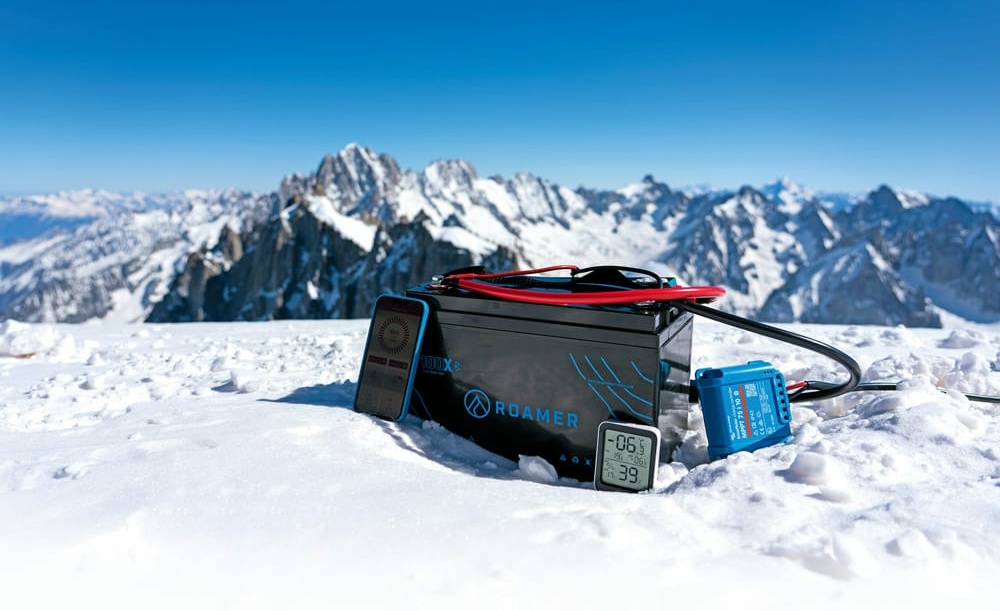
The 100XTREME, fitted with carry strap and weighing 11kg, is realistically portable.
Counterarguments
On the less positive side, the production of lithium batteries is controversial because to source or mine lithium, vast amounts of land are destroyed. You might have read about inhabitants living in areas where lithium is found being forced, in some cases, to leave their homes and relocate. Not only that, but the wildlife and flora native to these regions are destroyed, and in some cases irreparably so.
Lithium batteries in all their forms are extremely hard to recycle with thousands ending up in landfill. That said, there are specialist companies that will strip old batteries to remove such valuable components as nickel and cobalt. (With technology improving all the time, the processes involved should become more efficient, as well as easier. These same companies will sometimes reapply old batteries to less-demanding tasks).
As previously mentioned, the initial cost of a lithium-ion battery is higher than that of its traditional counterpart. This may deter some from investing in them. But perhaps the most pressing issue uppermost in many people’s minds is their record of safety – or rather the lack of it! Lithium batteries used in a variety of products have caused terrible fires due to overheating and combusting. Once alight, the fires are incredibly difficult, if not impossible, to distinguish. Such fires are not dependent on the appliance in question running or being used. Combustion can occur when the object is switched off, and when this happens, the consequence is explosive, occurring without any obvious warning. Imagine the destructive force such a super-heated fireball can have within the confines of a vessel’s garage.
Incidents
As the use of lithium batteries is becoming more significant, we are starting to hear more and more stories of incidents involving fires – a primary concern anywhere, but especially when it involves a vessel at sea. A few such incidents have made the headlines recently and caused maritime agencies to look again at the use of lithium batteries aboard vessels. Two such occurrences that captured the attention of the media were the lithium-based fires on board the Felicity Ace cargo ship, a container ship carrying a consignment of cars among its cargo of freight, and the MY Kanga, a superyacht carrying all the usual host of toys and ancillary items commonly found on a vessel of this type.
Safety tips
- Purchase and use devices that are listed by a qualified testing laboratory.
- Always follow the manufacturer’s instructions.
- Only use the battery that is designed for the device.
- Put batteries in the device the right way.
- Only use the charging cord that came with the device.
- Do not charge a device under your pillow, a bed or a couch.
- Do not keep charging the device or battery after fully charging.
- Keep batteries at room temperature when possible. Do not charge them at temperatures below 32°F (0°C) or above105°F (40°C).
- Store batteries away from anything that can catch fire.
Felicity Ace
In February 2022, the Felicity Ace sank after an unquenchable fire literally consumed the ship. It has been impossible to determine the initial cause of the fire, but due to the electric cars in its hold suspicions are the fire burned so vigorously due to these at least aggravating the fire. The incident started a response chain from the authorities and shipping companies, particularly the ferry operator, Havila Krystruten. Accordingly, the Norwegian company banned EVs from its passenger ships altogether, including hybrids and fuel-cell vehicles.
Havila Voyages MD Bent Martini, whose ships, in fact, use lithium batteries, told PBR: ‘We have requested an external assessment regarding the transporting of cars and motor vehicles on board the company’s coastal cruise ships. Proactima AS carried out the risk analysis, which led to Havila Voyages’ decision only to allow motor vehicles that use fossil fuel to join the vessel in selected ports along the coastal route. Electric, hybrid and hydrogen cars cannot be transported on board. Our decision is based purely on safety, and the conclusion of the risk analysis is that a possible fire in vehicles could not be solely handled by the systems and the crew we have on board.’
Paradoxically, Martini continued: ‘A possible fire in an electric, hybrid or hydrogen car will require external rescue efforts and could put people on board and the ships at risk. We take security seriously, and this is naturally a risk we are not willing to take under any circumstances. Havila Voyages’ ships are equipped with the world’s largest battery packs found on any such passenger ship and they are the most environmentally friendly ships that operate our Norwegian coastal route. The most important thing for us is to ensure the safety of our passengers and crew. Our ships are built with their own battery packs, and they are installed in accordance with current requirements for fire safety on ships. Our batteries are separated into isolated and fireproof rooms, with specific fire protection systems. Our batteries are also monitored continuously, but at the same time, we do not know the state of any battery belonging to a vehicle being brought on board our ships.’ You can see his point.
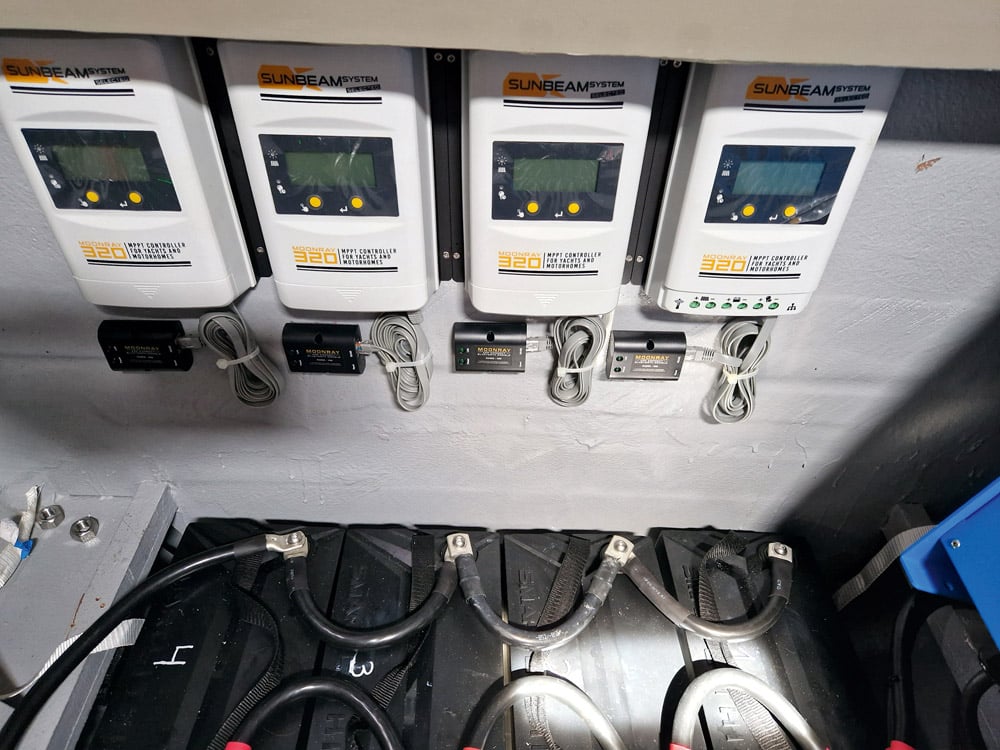
Sunbeam MPPT Controller installation.
MY Kanga
MY Kanga suffered a fire in its garage on 7th September 2018, with the result that the vessel had to be abandoned within minutes. The fire in the garage was so fierce that the attempts to suppress it were utterly in vain. The Marine Safety Investigation Unit of Malta concluded that the lithium batteries in one of the motor yacht’s toys housed within its garage had caused the resulting fire.
The findings of the Marine Safety Investigation Unit of Malta were as follows:
- The crew did not seem fully aware of the hazards associated with the li-ion batteries, which resulted in an inadequate assessment of the risks involved with these batteries, even after three of the four batteries were found to be leaking.
- The garage space of Kanga was not considered a service space within the meaning defined by the Commercial Yacht Code 2015; therefore, additional measures to prevent the spread of, and extinguish, the fire were not deemed necessary in the garage.
- Unlike SOLAS II-2/5.2.1.1, which requires the main inlets and outlets of all ventilation systems to be capable of being closed from the outside of the spaces being ventilated, as well as the means of closing to be easily accessible, the Commercial Yacht Code 2015 made this requirement only for ventilation ducts/fans of machinery spaces and galleys (Sections 11.1.3 and 11.2.2.1).
- Only Section 4.2.8.1 of the Commercial Yacht Code 2015 required ventilators to be provided with permanently attached means of weathertight closure, which were to be easily accessible. The Code did not address the means of closure from the point of view of air supply control, which could pose a potential for fire growth.
- The only means to detect a fire in the garage were through a photoelectric smoke detector and a fire patrol.
- There was no gas detector fitted in the garage, which could have provided an early warning of the situation there, probably even before the smoke detector triggered the fire alarm.
- No evidence of the garage extraction fan being stopped after the fire was discovered.
- A fire in the garage could only be extinguished by firefighters using the sole access from the galley. No fixed fire extinguishing system was installed on Kanga.
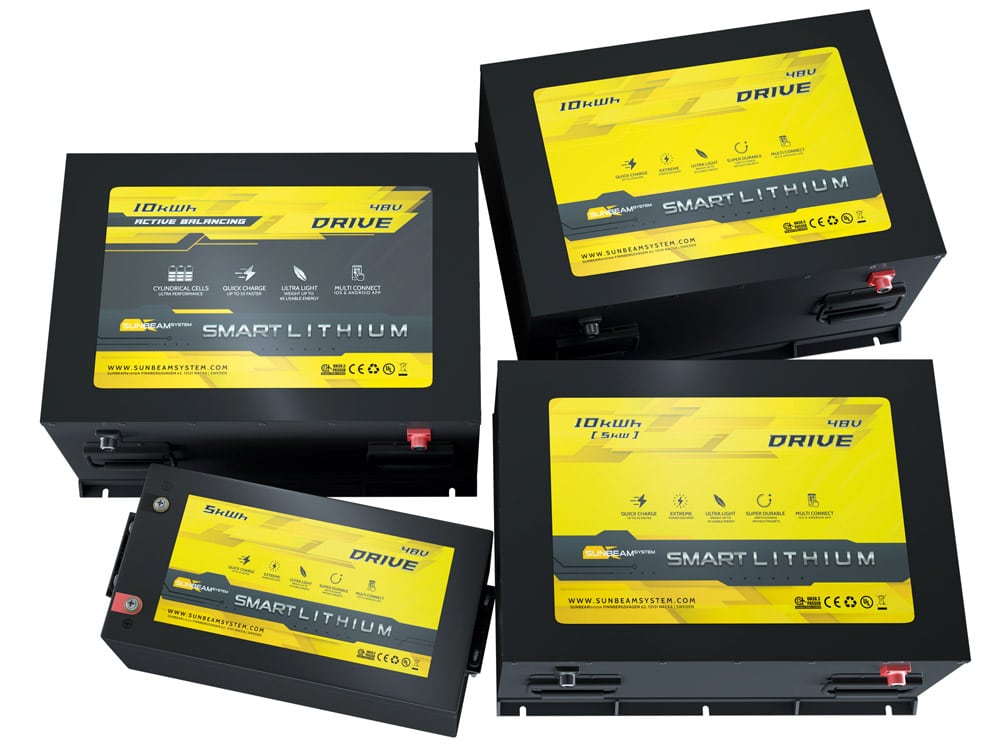
Smart Lithium batteries from Sunbeam system.
MV Fremantle Highway
The Fremantle Highway vehicle carrier carrying 3784 cars, included 498 electric vehicles and hybrids, suffered a catastrophic fire earlier this year. Initial responses indicated the EVs may have been responsible. However, this conclusion seems to have been premature as multiple reports suggest the electric cars were not to blame nor did they add to the blaze, being actually positioned on a lower deck less affected by the fire, and were reportedly within the around 1000 cars salvaged from the vessel in good condition. However, the incident has resulted in further discussion of the risks, as consideration has to be given to the potential hazards of EVs being exposed to an onboard fire.
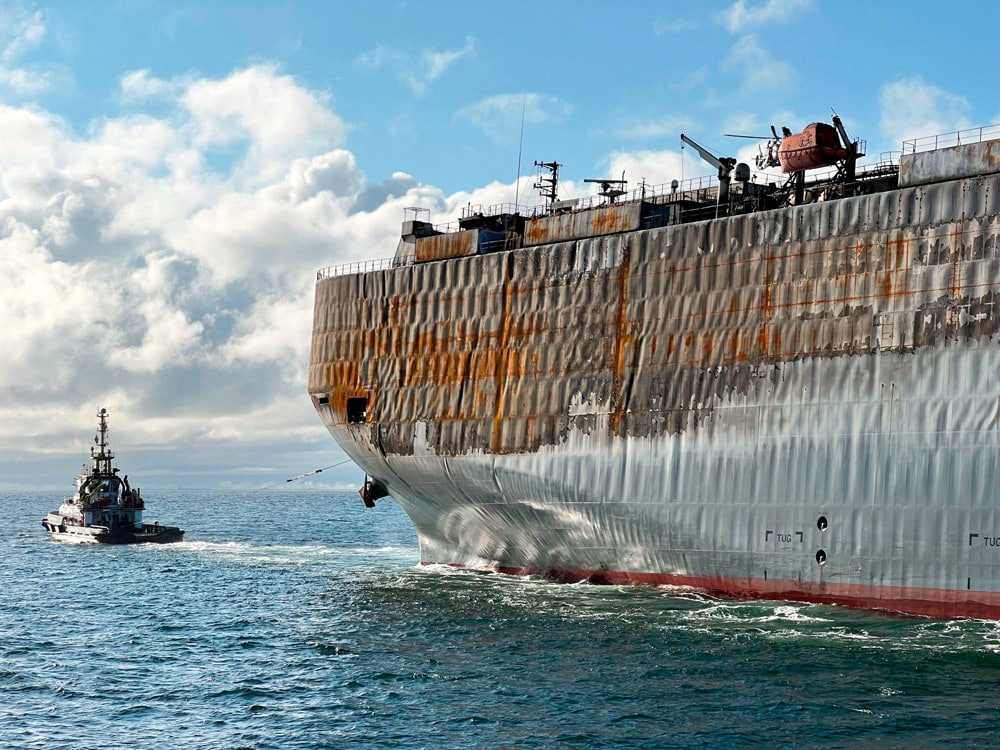
The Fremantle Highway had 3,784 cars aboard, 498 were electric cars. The incident is still under investigation but multiple reports indicate that these cars were not the actual cause of the fire nor did they exacerbate it.
The marine industry’s response
The whole of the maritime industry, surely, has had to rethink its use of lithium batteries following such incidents. Safety is paramount, and manufacturers, to their credit, are already responding to the potential but real dangers posed by this technology by altering their existing products or even creating new designs to help eliminate the risk of fire or explosion. Both RELiON and SUNBEAMsystem are among those leading the way in this ‘mark 11’ approach to making this use of lithium ion safer.
By way of example, RELiON have launched a 36V marine lithium battery, the RB36V40. This battery offers 20% greater performance than its series equivalent, thanks to its parallel design. The improved connectors and small Group 31 footprint simplify on-board installation and weigh 70% less than a lead-acid equivalent.
RELiON’s 36V battery has an IP67-rated case too, which completely repels dust and resists water ingress for up to 30 minutes submerged at 1 metre. An internal Battery Management System (BMS) monitors battery health and protects against short circuits and overcharging.
Swedish battery manufacturer SUNBEAMsystem, on the other hand, have launched the third generation of their ‘plug & play’ Smart Lithium battery series. It delivers higher-capacity density and performance and features 108Ah for its 12V system. This is an increase of 8% in the same casing with the same weight and the equivalent output of a 216Ah lead-acid battery. Its extended life and high capacity and efficiency make it the first choice for anyone needing a single battery.
Importantly, though, these lithium batteries have four layers of built-in security/protection in order to ensure, to the greatest degree possible, a really high degree of safety. For one, the chemistry of the batteries prevents any oxygen from being created in the event of a fire. Also, the batteries have built-in failsafe valves that only activate to make them inert if the battery comes into contact with fire. Their 24/7 software-based monitoring and prevention system also prevents short circuits, overvoltage issues, temperature changes and other battery misuse. And in the improbable event that a battery continues to be compromised, mechanical measures will render it inert. Another worthy attribute is a clever electronic control system that features a comprehensive range of automatic remedies to optimise the batteries. This means the advanced electronics keep the user up to date via the SUNBEAMsystem Multi Connect app. Particularly relevant to PBR’s readership, SUNBEAMsystem have upgraded their Smart Lithium DRIVE small-sized batteries for tenders and other small boats. This means that both their 12V and 24V trolling batteries have been upgraded to 1400Wh.
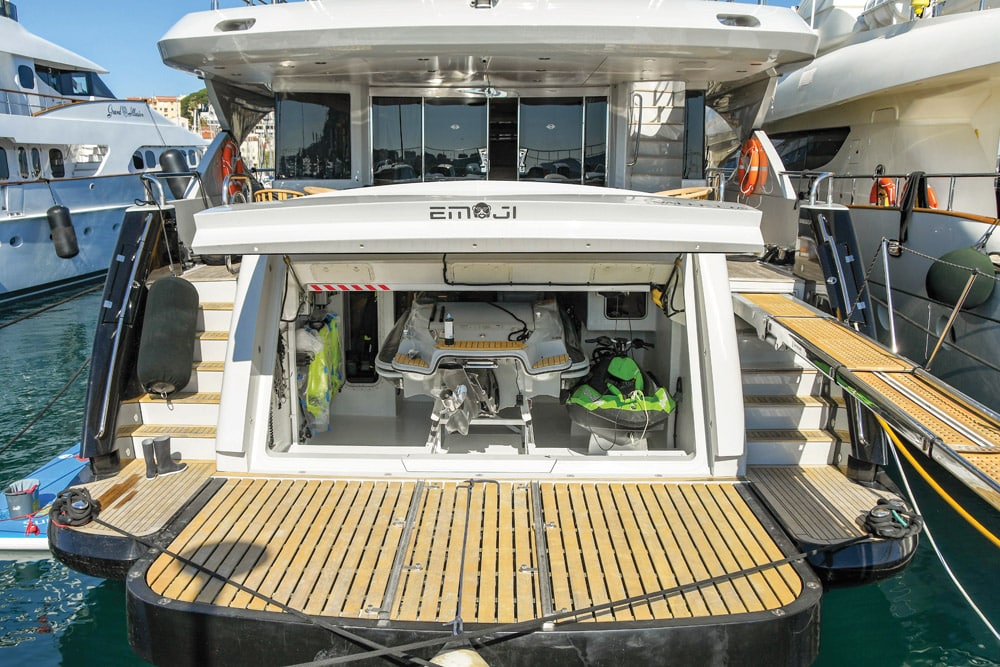
Particular care is needed if storing lithium powered ‘toys’ in a vessel’s garage.
Preventative measures
Leading marine technology brand Raymarine are already taking action to help boat owners detect lithium batteries overheating. The company recently issued a press release referencing their YachtSense Ecosystem, which integrates Teledyne FLIR AX8 thermal monitoring camera technology to help minimise lithium-ion battery fires by means of highly sophisticated detection processes. Teledyne FLIR, a leading manufacturer of maritime thermal systems, told PBR that they have already seen a marked increase in interest in their AX8 thermal monitoring camera system, which can continuously monitor the temperature state in multiple locations and enables owners to be warned immediately if a battery shows signs of overheating.
Hans Groenenboom, Sales Director of EMEAI Maritime Thermal Systems, Teledyne FLIR, explained: ‘It’s positive to see that there has been an increase in boat owners putting safety protocols in place to detect early warnings of a fire. By installing a thermal monitoring camera, owners are given extra time. They are not waiting for the smoke to be seen; the temperature change will sound the alarm long before that stage, providing valuable minutes to ensure the safety of those on board and the opportunity to extinguish the problem.’
A key benefit of thermal monitoring cameras like the AX8 is that they combine with other technology to remotely notify an owner of a fire, early. The AX8, for instance, can also integrate with Raymarine’s YachtSense Ecosystem, enabling complete on-board and off-board integration with all devices connected to the boat’s network.
Andy King, Vice-President of Sales at Raymarine, added: ‘Having modern vessel automation like our YachtSenseEcosystem allows a vessel owner to always be connected to their boat. An installed system ensures that captains and boat owners are aware of any activity on their vessel prior to, during and after their voyage. The AX8 camera can be connected directly to the YachtSense Link 4G router and will inform any boat owner by text message of any out-of-the-ordinary heat increases. Detecting a possible fire early will save huge losses and possibly save lives.’

Torqeedo Deep Blue lithium-Ion high voltage battery
British Marine’s ‘contribution’
Edward Tuite, Technical Manager at British Marine, explained his federation’s stance on this subject too, and in discussion with PBR he stated the following: ‘With any technology there are of course risks involved with its use. If we look at vessel design across the board, we have petrol systems, LPG systems, AC electrical systems, etc. All have inherent risks if not properly designed. I don’t see the use of lithium as being any different to any of these other aspects of design or use of technology. I would suggest too that the data backs this view up. We have all seen many of the well-documented thermal runaway fire accounts and read the resulting reports. Nearly all of these have not been attributed to the ship’s systems but rather the “toys” that have been carried aboard. Of course, I caveat that statement with the acceptance that it can often be difficult to determine the cause of a fire by the time the fire’s gone out!’
So what exactly are British Marine, as a federation responsible for representing the welfare of the industry they represent, doing? Well, it’s true that there has already been much work done by various ‘experts’ within the industry, including British Marine and several of their members, on ISO standard development in this area. This includes the first electric propulsion standard, ISO 16315, published in 2016 (see www.iso.org/standard/56158.html for more information on this). But essentially, and most pointedly, it covers the general design and installation of electric propulsion systems. It does not specifically cover lithium-ion batteries, however, and this would appear to be a significant failing on the part of the British Marine federation.
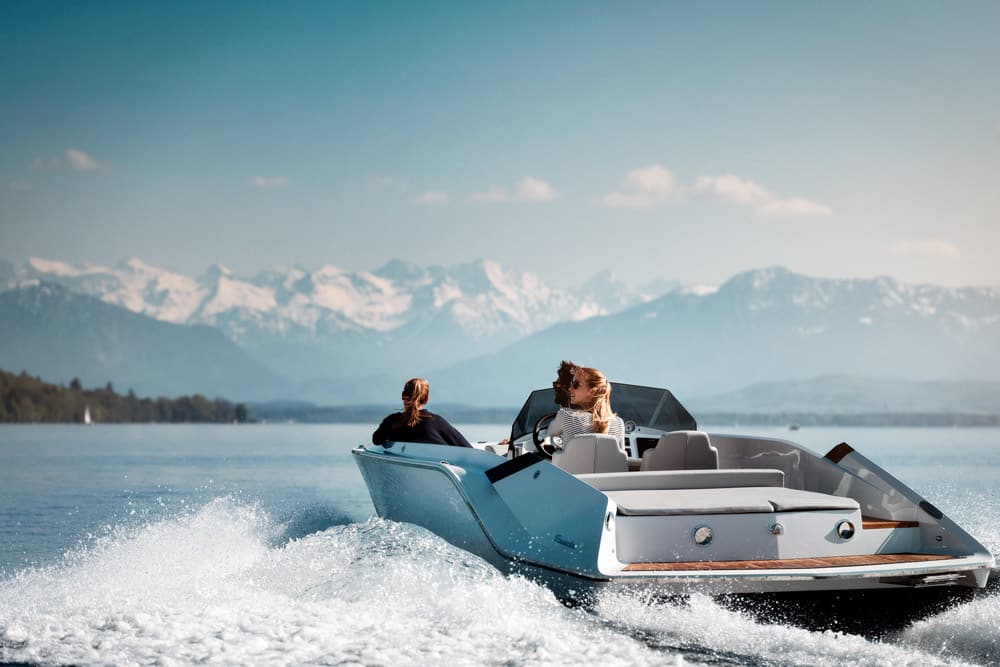
It must be recognised that as this technology becomes more and more prominent, there needs to be an official set of unilateral standards that have to be agreed and adopted. There is an urgency over this matter, because at this present time, it would appear that we’re playing a potentially deadly game of ‘catch-up’. Full ISO standards can take two years to develop, but having said that, there are quicker options available, such as the development of an ISO/TS. The latter still contains all the vital information, but there are less stringent rules and voting procedures, allowing for a more rapid rollout and adoption of policy. Take, for example, ISO/TS 23625:2021, which was developed and published in 2021. This particular TS standard covers the following, and I quote: ‘This document provides requirements and recommendations for the selection and installation of lithium-ion batteries for boats. It applies to lithium-ion batteries and to battery systems with a capacity greater than 600Wh installed on small craft for providing power for general electrical loads and/or to electric propulsion systems. It is primarily intended for manufacturers and battery installers.’
British Marine also have the BMEEA CoP – the BMEEA (British Marine Electrics and Electronics Association) Code of Practice – at their disposal. This provides the industry with a guide to safe practice, particularly with regard to electrical installations on small craft. Used by manufacturers and installers alike, this protocol constitutes one means of complying with the RCD/RCR and is recognised within the Maritime and Coastguard Agency Small Commercial Vessel Codes too.
Edward Tuite concluded by saying: ‘I would suggest there is enough information within our industry, certainly for new builds and for professional boatyards, etc., in order to help them mitigate the risks from lithium-ion batteries, certainly to the same level as other technologies. In general terms, this means the batteries are sourced from a reliable and reputable supplier and fitted – by a competent person – with a BMS in a secure way with the correct ventilation. Coupled with the advances in lithium technology (lithium phosphate is now the preferred technology), it means the technology itself is also getting safer.’
Well, all I can say is, let’s hope he’s right. Here at PBR, it’s our view that much more could and should be done in terms of legislation and the setting of industry standards: more guidance, more meaningful dialogue, and perhaps a greater desire on the part of certain agencies and federations, including our own British Marine, to achieve more advanced protocols and ISOs specific to this ever-growing form of auxiliary power. Instead of being behind the curve, let’s get ahead of it so that standards stay current with technology. After all, we don’t want to get our fingers burned, do we?
Danger signs
You should stop using the battery if you notice these problems: odour, a change in colour, too much heat, a change in shape, leaking or odd noises.
What to do in the case of a fire?
Lithium-ion battery fires are considered very difficult to extinguish. Attempts to fight these fires with a conventional hand-held fire extinguisher are usually unsuccessful, as lithium-ion cells produce the oxygen the fire needs to accelerate and proliferate. In addition, the extinguishing agents used have too little cooling effect to interrupt the reaction taking place. Water (in very large quantities) has therefore become the extinguishing agent of choice, at least for the fire brigade.
Beware: Every battery fire has a high potential for danger. Only tiny devices can be brought under control by the amateur firefighter. A burning smartphone, for example, can be extinguished with plenty of water and then placed in a larger container filled with water to cool the battery and prevent reignition. NB: Extreme caution must be exercised: the escaping gases are toxic and can harm health if inhaled.
Leave the area: If a larger battery catches fire, it can fill areas on the boat with toxic smoke within seconds. Endangered people should immediately seek safety and leave the affected area. There is a danger of explosion when extinguishing with water. If possible, the local fire brigade should be alerted immediately.
If the smoke development allows it, throwing the battery overboard can de-escalate the situation. This is illustrated by the case of a motor yacht insured with the marine insurance company Parthenius. In this particular case, the battery of an electric surfboard caught fire. Without suitable extinguishing agents, the crew’s only option was to throw the already smoking battery into the water to avoid damage to the yacht. This, of course, would only be suitable where no neighbouring berth holders could be endangered, and because of the possible environmental damage, it is the last viable option.
Alert firefighters: Not every fire from an electronic device is automatically a battery fire. However, it is not even apparent to professional firefighters whether or not a lithium-ion battery poses an acute danger. If a battery is damaged and a fire breaks out, temperatures of more than 1,500 degrees sometimes occur. The extinguishing water is split into hydrogen and oxygen at such high temperatures. This quickly creates a highly explosive air mixture, which can lead to a so-called ‘oxyhydrogen explosion’ if it comes into contact with even the most minor ignition source.
Devices with a larger lithium-ion battery should always be handled with appropriate caution in the case of fire – the distance when extinguishing must be as great as possible. If the fire brigade has been called to a fire, the firefighters must be informed about the items installed with lithium batteries.
The nature of a lithium fire
The triangle of fire – heat, fuel, oxygen – is the first thing a firefighter learns about on a fire safety course. But in the case of lithium battery fires, there is a tetrahedron of fire. There is also the additional effect of a chemical chain reaction. Once the thermal runaway starts, that fire is unstoppable. Flames too in a lithium battery fire will be pulled towards the nearest energy source.
Battery disposal
You should not put lithium-ion batteries in with the rubbish. Recycling is always the best option. Take them to a battery recycling location or contact your community re-cycling centre for disposal instructions. You should not put discarded lithium batteries in piles.
A stark warning
The growing risk of fire caused by lithium batteries was recently raised by Stream Marine Technical (SMT), an alternative fuel consultancy service that offers training in firefighting, sea survival, survival craft and other safety issues in the marine, oil and gas, and construction industries. They stated: ‘Awareness of the dangers is still dangerously low.’
A panel of speakers, including Tim Springett, Policy Director at the UK Chamber of Shipping, agreed with SMT’s view during the industry webinar ‘The deadly dangers of battery fires’. SMT director Tony Hout was recorded as saying: ‘Battery fires are normally caused by damage to the battery from a collision, incorrect charging, incorrect installation, incorrect storage or battery malfunction. The regulations are not really robust enough yet. Even if you have 85 firefighters on board, similarly to a standard cruise ship, they may be able to respond to the fire very quickly, but the challenge lies in dealing with a battery fire as they are very hard to put out. We do not have enough training in fire safety in terms of any of the alternative fuels that are coming into the industry.’

